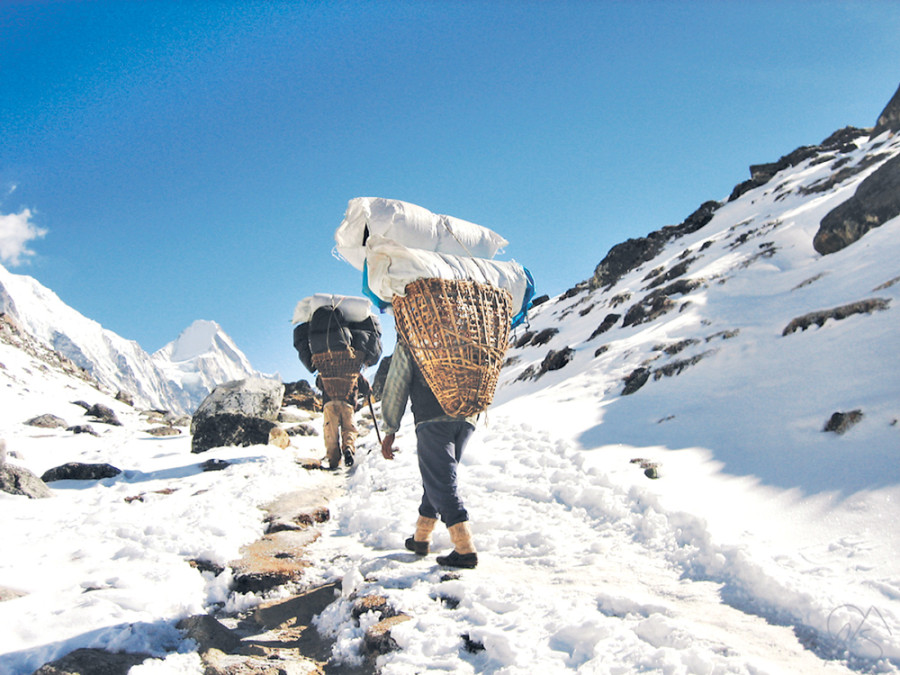Miscellaneous
Detranscendentalising Everest
Himalma Chalis Barsha is one of those rarest books that detranscendentalises Mount Everest and makes an objective description of it
Mahesh Paudyal
There are two types of literatures on Everest: the first, transcendentalising the peak as something indomitable and magical, and second, transcendentalising the climbers as extraordinary. Both the literatures are lopsided. The first category, written by masters of exaggerations—especially the poets and songsters—is hardly based on experience; they are mere imaginations or distanced abstractions. The second category of writing has been delivered by tourists and trekkers who have either themselves scaled Everest, or have tried and failed. Such works present the climbers as hyper-real, and is rather a narcissist venture. There really are very few writings that present Mount Everest as it really is, and that comes from those who have lived in and around the Himalayas all their lives. Lhakpa Phuti Sherpa’s recently delivered memoir Himalma Chalis Barsha is one of such works coming from an ‘insider’. A handiwork of a non-literary Sherpa woman, the book is based on her lived experiences on the high Himalayan Mountains for about forty years. The work is one of those rarest books that detranscendentalise Mount Everest and makes an objective description of it.
Phuti’s account, divided into 114 short chapters, underscores her life, right from her birth, through a poverty-torn girlhood, to a mature womanhood of experience and reason. She chronicles in detail how a Sherpa living on the high Himalayas runs into the mountains as a porter carrying loads of the foreign trekkers, and becomes a climber at the end. The transformation, which has become a part of culture today, is not devoid or risks, however. The involved dangers, as never foreseen by Everest enthusiasts, include hunger and thirst, cold and heat, exposure to hostile winds and snowfalls, sexual assaults, race and gender-related slights, underpayment and in some cases, death. Across the high Himalayan trails to Everest that last for many days and sometimes for many months, the Sherpas—both males and females—work like animals, and earn too little to manage a square of meals. Most Everest expeditions, achievements, and glories are founded on such sacrifices by the meek mountain-folks, who have made themselves a stair to the history of several winners from across the world, right from the days of Tenzing and Hillary.
The book deconstructs many myths about the Sherpas. It attacks the stereotypical representation of the community as a group of witless highlanders. Phuti’s position is that dealing with the hostility of the high Himalayas, including wind, avalanche, glacial ruptures and crevices, rain and dryness require immediate presence of mind and decision, which can come only from the brilliant-minded Sherpas. Her book is a celebration of their intellectual capacity, extraordinary problem-solving skills and courage. She puts at bay several preconceived interpretations of the Sherpas as gullible and ignorant village folks.
The memoir throws light on the difficulty of climbing Mount Everest, and risk on the part of the Sherpas—as cooks, guides and high-altitude workers—though all successful histories of Everest conquest never make a mention of it. The book, therefore, compensates for a literary violence and injustice deliberated on the Sherpas, who are the real stepping stones for conquerors to hoist their countries’ flags on the top of the world. The unnamed Sherpas, who still reel under extreme poverty and state’s negligence, are the real heroes of Everest adventure throughout history.
The book lays bare many factual details which force the readers to revise their earlier understanding about Everest adventures. Phuti’s account takes the government head-long, criticizing the apathetic attitude of the ministry of tourism in particular and the entire government in general. There is no shelter house for porters up there in the mountains, where they cannot afford expensive homes and lodges as the tourists can.
There is no mountaineering university in the country, owing to which the guides have to go abroad and pay heavy costs to learn about mountaineering. There is no guarantee of physical and sexual safety and health of women porters and guides, and the state does not seem serious about discovering and facilitating newer tourism spots in the mountains. The tourists, she claims, have nothing but the bare and inhospitable mountains to their service.
There are interesting episodes in the book about the poet’s personal attachment with national luminary Pasang Lhamu Sherpa. Their joint expedition uphill, in spite of the state’s reluctance to permit, was a feat of challenge by three women, of whom only Pasang Lhamu made it to the top, never to return home again. The story underscores several unknown facts about Pasang Lhamu, including her ambitious and strong nature, the last named being something that actually claimed her life on the mountains. The author’s account of mountaineering and skiing in several European countries gives readers a comparative picture of mountaineering in Nepal and abroad, and underlines avenues of immediate intervention and improvement.
To those who want to have an in-depth knowledge about high Himalayan trekking and climbing, this book will prove handy. It will force them to unlearn some earlier conceptions about the Sherpas, about Mount Everest itself and adventures on the mountains.
There book, however, has some room to improve. There are episodes that are very much personal and have nothing to do with mountaineering or Everest climbing, as promised by the title of the book. There is a sheer lack of coherence in the narrative, and at places, information is misleading. Very personal, familial and relational episodes which do not contribute to the real theme of the book are distractions; the author had better dispensed with them.




 7.12°C Kathmandu
7.12°C Kathmandu









%20(1).jpg&w=300&height=200)

